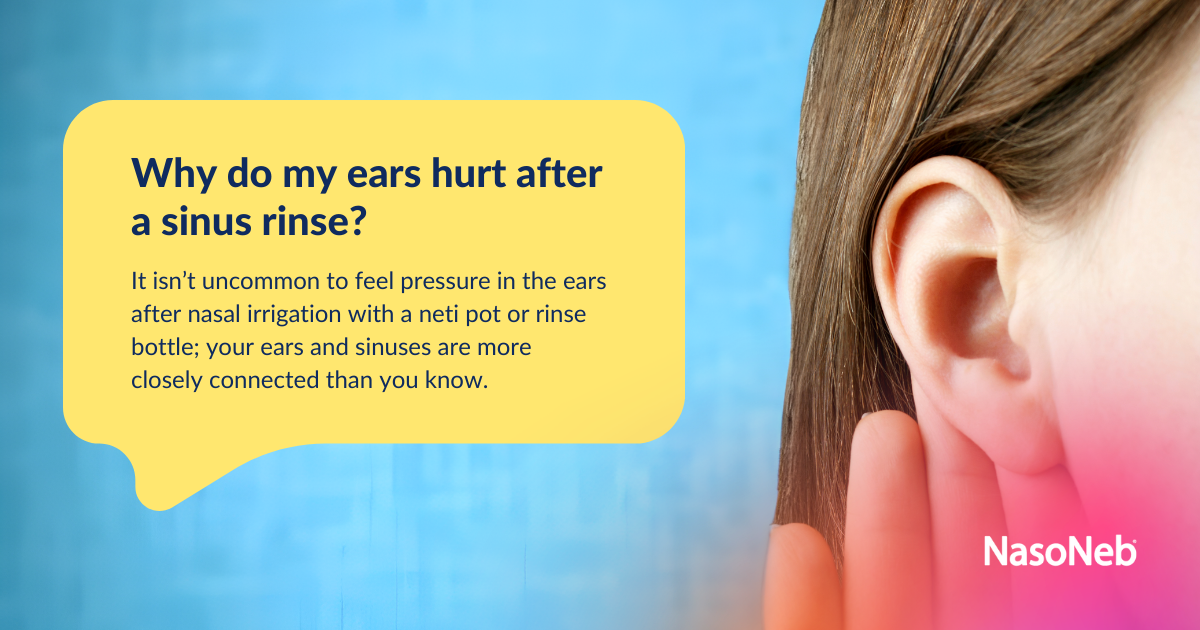
If you’ve dealt with chronic nasal congestion, you know the many benefits of sinus rinsing, otherwise known as nasal rinsing or nasal irrigation. From soothing a dry, irritated nose to cleaning infected sinus tissue, it’s no wonder frantically purchasing a sinus rinse kit from the local pharmacy is a universal experience for stuffed up sinus sufferers.
Understandably, many people are put off by the thought of flushing a cup of saline solution directly through their irritated nasal cavity. For others, this relief method has resulted in other concerning symptoms, including discomfort in the ears. In fact, this side effect isn’t uncommon; your ears and sinuses are more closely connected than you know.
Why do my ears hurt after flushing my sinuses?
The middle ear and back of the nose are directly linked by a canal called the eustachian tube, whose main function is to protect the middle ear by draining excess fluids, ventilating the middle ear, and equalizing air pressure between the eardrums.
Whether you use a squeeze bottle or a neti pot — a high-volume flush of saline solution is sometimes enough to offset this delicate balance. It’s important to avoid improper technique when draining your sinuses with a nasal irrigation device.
Common mistakes you might be making with your sinus rinse:
- Overusing the device or using too much solution
- Applying too much force
- Tilting your head at the wrong angle
- Using with existing ear problems
In some cases, ear pressure can be a symptom of existing sinus congestion, so trying a nasal rinse is often beneficial to relieve the pressure. It’s important to uncover the root cause of your discomfort, and follow the proper usage guidelines of your chosen nasal irrigation device.

How do I unclog my ears after a sinus rinse?
Congestion worse after a sinus rinse, particularly in your ear canal? If you feel like you have water trapped in your ears from sinus rinsing, you can try a few things:
Steam and hydration
A warm, moist environment loosens mucus and opens the nasal passages. Try steaming your face over a bowl of hot water. Drape a towel over your head to insulate the steam and take deep, controlled breaths in and out.
Avoid breathing in dry air, as this can further irritate the nasal passages. Use a humidifier and be sure to properly hydrate throughout the day to keep nasal mucus thin.
Massage and body positioning
Tilt your affected ear towards the same-side shoulder. Create movement around the blocked site; lightly tug your ear lobe and apply pressure around the opening of the ear and jiggle the area.
Gravity can help, too. Try lying down on the same side as your clogged ear.
Over-the-counter or prescribed intranasal medication
A medicated nasal spray formula can provide great relief for sinus-related pain and inflammation. Your physician might recommend or prescribe a nasal steroid, decongestant, antibiotic, or antihistamine.
Whether you choose a medicated formula or a natural decongestant, treating your sinuses can help to relieve pressure in the eustachian tube.
Pain medication
Over-the-counter pain relief like Ibuprofen and Acetaminophen can help to relieve pain associated with sinus pressure.
Wait it out
Ear discomfort often resolves itself, however, if your symptoms become more severe or last beyond a couple days, consult your physician for next steps.
How can I prevent ear pain from sinus rinsing?
Use a commercially-mixed saline solution
The saline solution provided with your sinus rinse kit contains the right balance of sterile ingredients to properly clean the nose without further irritating the delicate nasal lining. Be cautious about mixing your own solution at home, as too high a salt concentration can dry out nasal mucosa and lead to inflammation.
Warm saline solution before use
Warm water can make saline solution more tolerable, soothing the nasal passages and minimizing risk of pain.

Switch to a gentle nasal cleaning device
If you're looking for a squeeze bottle or neti pot alternative because you can't tolerate a forceful flush, try a low-volume tool like an aerosol-powered nasal nebulizer.
Unlike flush systems, nasal nebulizers are designed to transform liquid formulas into a fine mist that coats the entire nasal cavity. In side-by-side comparisons, the NasoNeb® Sinus Therapy System delivered up to 98% more medication to the middle and back of the nose than standard delivery tools like spray pumps and rinse bottles. This way, nasal medication arrives to the inflamed tissue deep in the nasal cavity.
Determine the root cause of your ear pain
An earache can be a symptom of other health concerns like eustachian tube dysfunction, swimmer's ear (otitis externa), sinusitis — even TMJ (temporomandibular joint syndrome) and dental problems! These conditions can cause referred pain to the ears.
Keep a log of your symptoms; recurring sinus infections (chronic rhinosinusitis) may require more extensive therapies than simple nasal lavage.
Consult with your physician
If you are experiencing chronic ear pain after using a nasal irrigation device, it's best to pause that part of your sinus relief routine until you can see a specialist. Your family doctor or Ear, Nose & Throat specialist can guide you through the tools and techniques that work for your individual needs.
